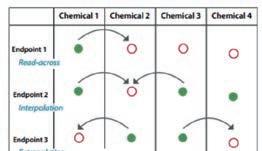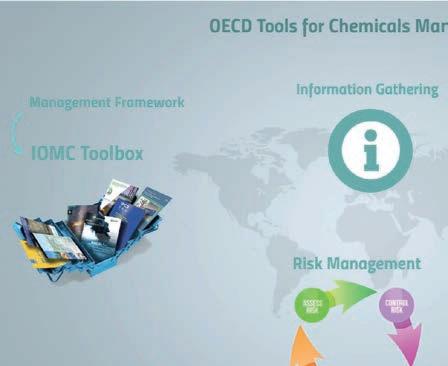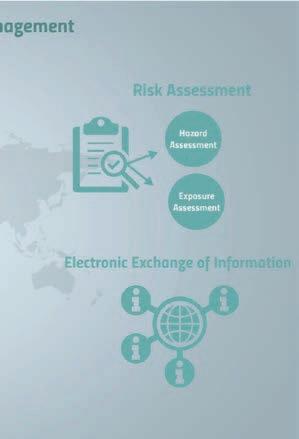
8 minute read
New methodologies: working towards regulatory use
The OECD promotes the regulatory use of new instruments for gathering information on the safety of chemicals and for making best use of scientifi c advances in chemicals management. With these tools, it becomes possible to obtain more safety information and maintain quality while reducing costs, time and animal testing.
A number of OECD Test Guidelines are already based on non-animal tests, including but not limited to skin corrosion, phototoxicity and skin absorption, serious eye damage, skin sensitisation, genotoxicity and endocrine disruption. As new tests which meet the regulatory safety requirements of the OECD member countries are developed and validated, the range of non-animal Test Guidelines available will increase. There is an on-going eff ort to combine alternative test methods for a same endpoint and provide guidance for their rational use. A long-term goal is to reach agreement among countries on defi ned replacement methods to avoid or strongly reduce animal testing.
Non-animal testing
The OECD is committed to reducing or avoiding animal suff ering and limiting the number of test animals used. Many of the current OECD Test Guidelines are based on tests conducted on animals, with clear guidance to minimise pain and suff ering in the animals during testing.
The OECD is actively working towards the development of methods to replace animal tests where possible, or to refi ne existing tests to reduce the number of animals used and minimise suff ering.
Key link:
www.oecd.org/chemicalsafety/tes� ng/animal-welfare
(Quantitative) Structure Activity Relationships [(Q)SARs]
(Q)SARs are methods involving computer simulations which estimate properties of a chemical from its molecular structure. The use of (Q)SARs in chemicals regulation is growing and the OECD is looking at how these approaches can be further implemented in member countries.
The OECD QSAR Toolbox allows users to predict the properties of chemicals from the knowledge of close structural analogues.
The seminal features of the Toolbox are:
l Identifi cation of relevant structural characteristics and potential mechanism or mode of action of a target chemical; l Identifi cation of other chemicals that have the same structural characteristics and/or mechanism or mode of action; l Use of existing experimental data to fi ll data gap(s) by read- across, interpolation or extrapolation.
Chemical Categories Category Approach
Key link:
oe.cd/qsar-toolbox
Adverse outcome pathways (AOPs)
Faced with the daunting task of assessing the safety of thousands of chemicals using existing data or alternative approaches to animal testing, member countries have no choice but to develop new tools and decision frameworks.
The OECD Adverse Outcome Pathways Development (AOP) Programme was launched in 2012 to enable collaborative eff orts among researchers to delineate structured knowledge derived from chemicals interactions with biological targets and subsequent testable key events leading to adverse health or environmental eff ects. Adverse Outcome Pathway
Level of Biological Organisation

Molecular Organelle Cellular Tissue Organ Organism Population
in silico in chemico in vitro
in vivo field and epidemiological studies
Chemicals initially interact with a molecular target (molecular initiating event or MIE). The MIE initiates a biological cascade of events; triggering eff ects in cells, tissues and organs (Key Events (KE)) that potentially result in an adverse outcome (AO) in an individual (solid line) or population (dotted line). The description of this cascade of biological events is called an Adverse Outcome Pathway (AOP).
What is an AOP? Where can I find AOPs?
An AOP is an analytical construct that describes a sequential chain of causally linked events at different levels of biological organisation that lead to an adverse health or ecotoxicological effect (see figure on page 24). AOPs are the central element of a toxicological knowledge framework being built to support chemical risk assessment based on mechanistic reasoning. The knowledge gathered in AOP’s can then be used to: l develop (Q)SARs and non-animal test methods l develop testing strategies l interpret non-standard test results published in the scientific literature.
Key publication
Guidance Document for the Use of Adverse Outcome Pathways in Developing Integrated Approaches to Testing and Assessment (IATA)
Series on Testing and Assessment No. 260 The Guidance Document on the Use of the Adverse Outcome Pathways in developing Integrated Approaches for Testing and Assessment (IATA): l Provide a framework for developing and using
IATA l Describe how IATA can be based on the Adverse
Outcome Pathway (AOP concept) l Provide examples on how AOPs can be used in the development of IATA. The AOP Knowledge-Base and tools: The eAOP Portal is the main entry point of the AOP Knowledge Base. As a search engine, the Portal enables search by key words in AOP titles and key events in the AOP Wiki and Effectopedia platforms. The AOP Wiki provides a system that organises, via crowd-sourcing, the available knowledge and published research into a verbal description of individual pathways, using a user friendly Wiki interface.
AOPs are the central element of a toxicological knowledge framework, promoted by member countries through OECD, built to support chemical risk assessment based on mechanistic reasoning. These AOPs are available in the AOP Wiki, an interactive and virtual encyclopedia for AOP development. Following their development and review, the endorsed AOPs are published in the OECD Series on Adverse Outcome Pathways.
Key links:
https://aopkb.oecd.org https://aopwiki.org https://doi.org/10.1787/2415170X
Key link: oe.cd/iata
Common electronic formats
The formats used by companies and governments to report summary results of chemical tests vary widely, making it diffi cult for governments to share this information.
As a result, for each of the Test Guidelines, the OECD has developed a corresponding “harmonised template” which constitute a guide for structuring data when reporting summaries of the results from those tests.
The OECD has also created common electronic data export/import formats for these templates to facilitate the exchange of such information across computer systems, as increasingly needed for meta-analyses, cross- check of data and cost saving in data management.
Key links:
www.oecd.org/ehs/templates



OECD IT tools supporting chemicals management
In this presentation, you will fi nd a full description of each tool, how they fi t in the general process of chemicals management, e.g. information gathering and information generation, risk assessment (hazard and exposure assessment) and risk management and how they facilitate retrieval and exchange of data within and between programmes and jurisdictions.
Key link: oe.cd/it-tools

4Safety of manufactured nanomaterials
OECD work continues to evolve in response to the safety of emerging and converging technologies such as manufactured nanomaterials (MNs).
What is nanotechnology?
Nanotechnology is the engineering of materials at the atomic or molecular level to produce nanomaterials. Nanotechnologists normally work with nanomaterials which have dimensions typically within the range of 1-100nm. A nanometer is about 1/80,000th the width of a human hair and a sheet of office paper is about 100,000 nm thick.
Nanomaterials are not specific to one industrial sector but appear in many, from electronics and computing, to the chemicals industry, environmental technologies, medicine, cosmetics, foods, the military and the energy sector. Nanomaterials are already used in many commercial applications ranging from lotions, creams and shampoos in the cosmetics sector to self-cleaning glass, tyres or fabrics.
Promoting safer(r) and more sustainable nanomaterials
The OECD keeps abreast of major policy issues related to manufactured nanomaterials, advanced materials and other emerging issues. For instance, to minimise the gap between technological innovations and the development of suitable risk assessment tools and frameworks. A report addressing safe(r) innovation approach for sustainable nanomaterials and nano-enabled products has recently been published. Further work is underway to assist countries in bringing together safety and sustainability.
Other efforts include developing tools to assist countries in assessing the exposure to nanomaterials. To this end, the OECD is reviewing the applicability of exposure existing tools/models to manufactured nanomaterials in occupational, consumer and environmental domain.
Key link:
oe.cd/nanosafety nanomaterials

Towards tailored safety testing methods for nanomaterials
Because Nanomaterials may have diff erent properties compared to the same substance in bulk form, there is a need to have internationally standardised test methods to characterise nanomaterials, their physicalchemical properties, environmental fate, eff ects on environmental species and on human health. To intensify this endeavour, the NANOMET project, funded by the European Union, was launched in May 2020. Webinars are regularly organised to inform governments, industry and independent laboratories on the use of OECD testing methods.
OECD legal instrument on Nanomaterials
The OECD Council Recommendation on the Safety Testing and Assessment of Manufactured Nanomaterials was approved in 2013 following seven years of work on the topic. It recommends applying existing regulatory frameworks for traditional chemicals to nanomaterials, while it is understood that some adaptation might needed to take into account the properties specifi c to nanomaterials. It also recommends applying the OECD Test Guidelines in the testing of MNs, updating existing Test Guidelines and developing new ones specifi c to MNs. This has important consequences in that the safety assessment data of MNs will fall within the scope of the OECD system for the Mutual Acceptance of Data.
Webinars on nanomaterials:

• Webinar on aquatic (including sediment) ecotoxicity testing of
nanomaterials for the purposes of determining their hazard.
This webinar presented the scope and use of the guidance document No. 317 on aquatic and sediment ecotoxicity testing of nanomaterials. The guidance addresses practical aspects of carrying out valid tests on nanomaterials, and modifi cations or additions to OECD Test Guidelines procedures intended to improve the accuracy of test results. l https://youtu.be/MKhSzqQIHZc
• Webinar on the dispersion stability and dissolution rate of nanomaterials
in the environment.
This webinar presented the scope, content, and use of the Test Guideline No.
318: Dispersion Stability of Nanomaterials in Simulated Environmental
Media and its accompanying Guidance Document. l https://youtu.be/ODEQGkFonAo
Key link:
oe.cd/nanomet






